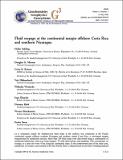Por favor, use este identificador para citar o enlazar a este item:
http://hdl.handle.net/10261/104085COMPARTIR / EXPORTAR:
 SHARE SHARE
 CORE
BASE CORE
BASE
|
|
| Visualizar otros formatos: MARC | Dublin Core | RDF | ORE | MODS | METS | DIDL | DATACITE | |

| Título: | Fluid seepage at the continental margin offshore Costa Rica and southern Nicaragua |
Autor: | Sahling, Heiko; Masson, Douglas G.; Ranero, César R. CSIC ORCID; Hühnerbach, Veit; Weinrebe, Wilhelm; Klaucke, Ingo; Bürk, Dietmar; Brückmann, Warner; Suess, Erwin | Palabras clave: | Chemosynthetic community Authigenic carbonate Subduction erosion |
Fecha de publicación: | may-2008 | Editor: | American Geophysical Union | Citación: | Geochemistry, Geophysics, Geosystems 9(5): Q05S05 (2008) | Resumen: | A systematic search for methane-rich fluid seeps at the seafloor was conducted at the Pacific continental margin offshore southern Nicaragua and northern central Costa Rica, a convergent margin characterized by subduction erosion. More than 100 fluid seeps were discovered using a combination of multibeam bathymetry, side-scan sonar imagery, TV-sled observations, and sampling. This corresponds, on average, to a seep site every 4 km along the continental slope. In the northwestern part of the study area, subduction of oceanic crust formed at the East Pacific Rise is characterized by pervasive bending-induced faulting of the oceanic plate and a relatively uniform morphology of the overriding continental margin. Seepage at this part of the margin typically occurs at approximately cone-shaped mounds 50 - 100 m high and up to 1 km wide at the base. Over 60 such mounds were identified on the 240 km long margin segment. Some normal faults also host localized seepage. In contrast, in the southeast, the 220 km long margin segment overriding the oceanic crust formed at the Cocos-Nazca Spreading Centre has a comparatively more irregular morphology caused mainly by the subduction of ridges and seamounts sitting on the oceanic plate. Over 40 seeps were located on this part of the margin. This margin segment with irregular morphology exhibits diverse seep structures. Seeps are related to landslide scars, seamountsubduction related fractures, mounds, and faults. Several backscatter anomalies in side-scan images are without apparent relief and are probably related to carbonate precipitation. Detected fluid seeps are not evenly distributed across the margin but occur in a roughly margin parallel band centered 28 ± 7 km landward of the trench. This distribution suggests that seeps are possibly fed to fluids rising from the plate boundary along deep-penetrating faults through the upper plate. Copyrignt 2008 by the American Geophysical Union | Descripción: | 22 pages, 13 figures, 1 table, supporting information http://onlinelibrary.wiley.com/doi/10.1029/2008GC001978/suppinfo | Versión del editor: | https://doi.org/10.1029/2008GC001978 | URI: | http://hdl.handle.net/10261/104085 | DOI: | 10.1029/2008GC001978 | Identificadores: | doi: 10.1029/2008GC001978 e-issn: 1525-2027 |
| Aparece en las colecciones: | (ICM) Artículos |
Ficheros en este ítem:
| Fichero | Descripción | Tamaño | Formato | |
|---|---|---|---|---|
| Sahling_et_al_2008.pdf | 6,52 MB | Adobe PDF |  Visualizar/Abrir |
CORE Recommender
SCOPUSTM
Citations
114
checked on 10-abr-2024
WEB OF SCIENCETM
Citations
94
checked on 28-feb-2024
Page view(s)
343
checked on 18-abr-2024
Download(s)
365
checked on 18-abr-2024
Google ScholarTM
Check
Altmetric
Altmetric
NOTA: Los ítems de Digital.CSIC están protegidos por copyright, con todos los derechos reservados, a menos que se indique lo contrario.
